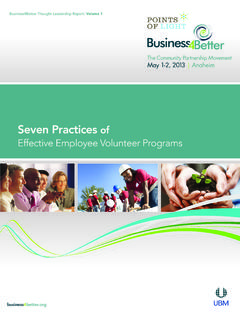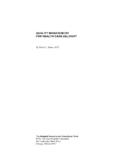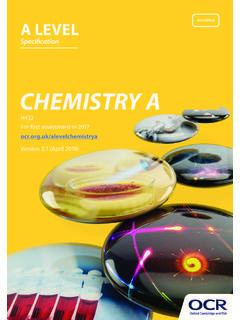Transcription of Introduction to I - Penumbra
1 Introduction to 1 Introduction Penumbra is a leading Scottish Voluntary Organisation working in the field of mental health. We provide an extensive range of person-centred services for adults and young people. (Individual Recovery Outcomes Counter) is an Outcome Measurement tool created by Penumbra in order to measure the recovery journey of people who use our services. Recovery is the realisation of a meaningful and fulfilling life in the presence or absence of any mental health problems. All our work aims to ensure that we remain hopeful and focused on positive outcomes for people with mental health problems. Our aim in the development of was that we would develop a tool that would facilitate the personalisation of services and improve the wellbeing of people who used our services. Personalisation means that rather than presuming that a one size fits all , services enable people to have care and support built around their personal needs, choices and aspirations.
2 Ensuring that people move from being (passive) recipients of pre-determined services to being active participants in shaping the support that meets their needs, aspirations and chosen lifestyle. For some people personalisation will be about having effective, reliable and consistent off the shelf services . For others it will be the opportunity to utilise informal support networks more effectively with the knowledge that expert back-up support will be available during times of crisis or difficulty. And for others it will be the availability of knowledge, information and skills training that will enable self-management of their personal situation. The principles of recovery, personalisation and outcome measurement are shaping the direction of service provision but developing tools locally that are effective in measuring results in these areas remains a key challenge.
3 We were keen to address this in order to deliver the best possible outcomes for people within an organisational culture of continuous improvement. Our Challenge was to create an outcomes tool that is: Easy To Use Valid Secure Cost Effective Linked to an Outcomes Based Approach Our Solution I. Introduction to 2 is a facilitated self-assessment questionnaire that seeks to measure recovery using our HOPE Model of wellbeing: Home - a safe and secure place to live Opportunity - to pursue meaningful leisure, recreation, education and work possibilities People - as friends, confidantes and supporters Empowerment - fully involved in decisions affecting own life : consists of: 3 indicators for each of the 4 areas of HOPE that form the basis of Penumbra s model of wellbeing.
4 Each of the indicators has been validated as a factor linked to Recovery. In this example the darker inner area displays the 1st and baseline score and the lighter, outer area displays the scores when was reviewed 3 months later. Scores can be analysed at a personal, service and organisational level. Introduction to 3 Using For each of the above 12 indicators the person is asked to provide a score: Graphics and prompts are provided for each question to assist the person completing and for the worker facilitating. (Comprehensive supporting guidance is available to staff that gives general guidance in relation to completing , together with specific guidance relevant for each indicator.) All 12 questions are therefore considered and scores for each indicator are recorded on an answer sheet.
5 Results are then transferred to secure database. Tear off allow the person to have an immediate graphic illustration of their own results: The answer sheet also has space to gather narrative for each of the indicators so significant events, thoughts, reflections, comments can be gathered Introduction to 4 and a Personalised Outcomes Based Approach is not simply a validated measure of recovery but forms the basis of an outcomes based approach also based on HOPE Model. The spidergram visually shows the person and a key worker the individual areas of comparative strength, and areas that are a priority to work on. By identifying these areas, we can work out a personalised programme of support to address the areas that are having the biggest impact on wellbeing. In order to enable this we have developed a HOPE Toolkit that is linked to the indicators.
6 The Toolkit contains guidance plans, tools, wellbeing tips and links to other resources. The Toolkit facilitates the identification of personal outcomes and provides a range of self management techniques that are designed to help the person work towards those outcomes: This can be used to form the basis of an outcome focused, personalised and educational support package that promotes wellbeing and self-management. Validation The increasingly widespread use of I-ROC across the organisation and beyond highlighted the need for to be validated as a robust and reliable measure. Validation of was particularly important if it is to be used as evidence to external bodies in respect of the effectiveness of Penumbra s services and if the tool is to be made available to other organisations. Penumbra has been working with the Abertay University since 2011 in order to assess the validity and reliability of In 2013, researchers at the two institutions published a paper in The Psychiatrist outlining the tool s psychometric properties (Monger et al, 2013).
7 This included high internal consistency, and good convergent validity with two leading measures of recovery (Recovery Assessment Scale) and outcomes (BASIS-32). The research group also Introduction to 5 published a paper in the British Journal of Mental Health Nursing demonstrating s face validity and usability (Ion et al, 2013), concluding that people should consider the use of the as a means of assessing the services user s position on their journey to recovery, as an aid to care and support planning, and a means of focusing therapeutic interactions (Ion et al, 2013). Research into is continuing, with current projects further assessing its validity and reliability in a number of contexts both in the UK and abroad. Future Developments Penumbra is now working with Scottish web developers MTC Media Ltd to turn this successful system into an App and Website-based tool, which we hope to launch later in 2015.
8 Has been a fantastic success and developing an app for users seemed like the next most assessment tools which contain a long list of questions, was designed as a colourful, graphic rich, booklet. Its strength lies in the fact that it measures recovery over time, rather than symptoms and level of illness. This new app will build on this ethos and make even more accessible ad interactive. Further Information . If you require more information, or have any further questions please contact Jane Cumming, Development Manager T: 07795043751 E: Or Bridey Monger, Research and Information Officer T: 07799545050 E: Introduction to 6 Links Penumbra Website: : MTC: Outcomes: References Ion R, Monger B, Hardie S, Henderson N, Cumming J (2013). A tool to measure progress and outcome in recovery. British Journal of Mental Health Nursing, 2(4), 56-60 Monger B, Hardie S, Ion R, Cumming J, Henderson N (2013).
9 The Individual Recovery Outcomes Counter: Preliminary validation of a personal recovery measure. The Psychiatrist, 37, 221-227 Monger B, Ion RM, Henderson N, Cumming J, Hardie SM (2012). Outcome measurement in a Scottish mental health charity. Mental Health Today March/April, 24 27 BASIS-32 Eisen SV (1996) Behavior and Symptom Identification Scale (BASIS-32). In: Sederer LI, Dickey B, eds. Outcomes Assessment in Clinical Practice. Lippincott Williams and Wilkins, Philadelphia, PA: 65 9 RAS Giffort D, Schmook A, Woody C, Vollendorf C, Gervain M. Recovery Assessment Scale. Illinois Department of Mental Health, 1995. Penumbra , Norton Park, 57 Albion Road, Edinburgh, EH7 5QY T 0131 475 2380 | F 0131 475 2391 W E Penumbra is a charity (SC 010387) and a company limited by guarantee (SC 091542) registered in Scotland







